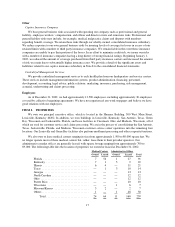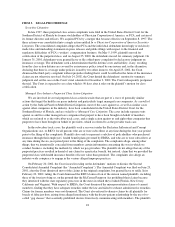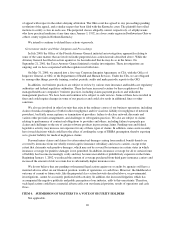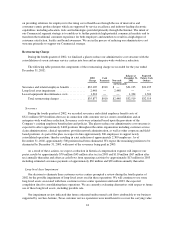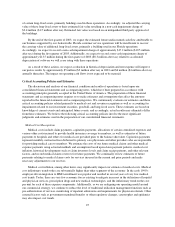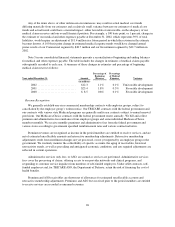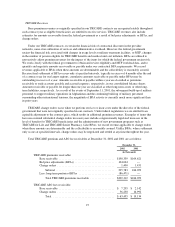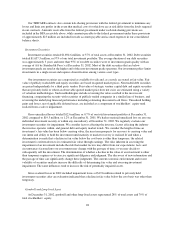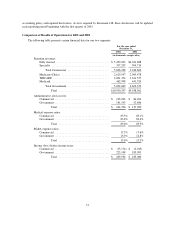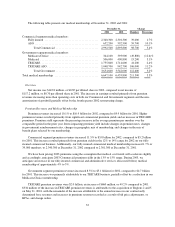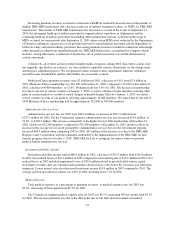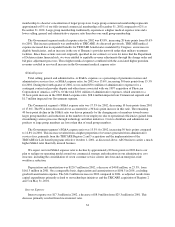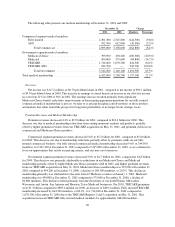Humana 2002 Annual Report Download - page 32
Download and view the complete annual report
Please find page 32 of the 2002 Humana annual report below. You can navigate through the pages in the report by either clicking on the pages listed below, or by using the keyword search tool below to find specific information within the annual report.
Any of the items above, or other unforeseen circumstances, may result in actual medical cost trends
differing materially from our estimates and a relatively small variance between our estimates of medical cost
trends and actual trends could have a material impact, either favorable or unfavorable, on the adequacy of our
medical claims reserves and our overall financial position. For example, a 100 basis point, or 1 percent, change in
the estimate of our medical and other expenses payable at December 31, 2002, which represents 39% of total
liabilities, would require an adjustment of $11.4 million in a future period in which the revision in the estimate
becomes known. A 100 basis point change in estimated medical expense trends would have changed annual
pretax results of our Commercial segment by $48.7 million and our Government segment by $42.7 million in
2002.
Note 5 in our consolidated financial statements presents a reconciliation of beginning and ending balances
for medical and other expenses payable. The table includes the changes in estimates of medical claims payable
subsequently recorded to each year. A summary of these changes in estimates and percentage of beginning
medical claim reserves follows:
Year ended December 31, Amount
Percentage of
Beginning
Reserves
Percentage
of Medical
Expenses Variance
(in millions)
2002 ........................... $12.3 1.1% 0.1% Unfavorable development
2001 ........................... $23.4 1.8% 0.3% Favorable development
2000 ........................... $ 8.5 0.6% 0.1% Favorabledevelopment
Revenue Recognition
We generally establish one-year commercial membership contracts with employer groups, subject to
cancellation by the employer group’s written notice. Our TRICARE contracts with the federal government and
our contracts with various state Medicaid programs are generally multi-year contracts subject to annual renewal
provisions. Our Medicare+Choice contracts with the federal government renew annually. We bill and collect
premium and administrative fee remittances from employer groups and some individual Medicare+Choice
members monthly. We receive monthly premiums and administrative fees from the federal government and
various states according to government specified reimbursement rates and various contractual terms.
Premium revenues are recognized as income in the period members are entitled to receive services, and are
net of estimated uncollectible amounts and retroactive membership adjustments. Retroactive membership
adjustments result from enrollment changes not yet processed, or not yet reported by an employer group or the
government. We routinely monitor the collectibility of specific accounts, the aging of receivables, historical
retroactivity trends, as well as prevailing and anticipated economic conditions, and any required adjustments are
reflected in current operations.
Administrative services only fees, or ASO, are earned as services are performed. Administrative services
fees cover the processing of claims, offering access to our provider networks and clinical programs, and
responding to customer service inquiries from members of self-funded employers. Under ASO contracts, self-
funded employers and, for TRICARE ASO, the Department of Defense, retain the risk of financing the cost of
health benefits.
Premium and ASO receivables are shown net of allowances for estimated uncollectible accounts and
retroactive membership adjustments. Premiums and ASO fees received prior to the period members are entitled
to receive services are recorded as unearned revenues.
26



